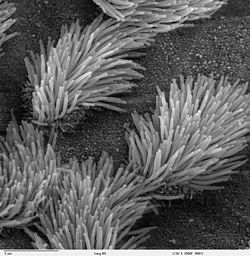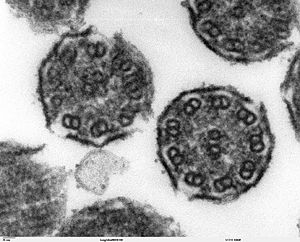Difference between revisions of "Cilium" - New World Encyclopedia
Rick Swarts (talk | contribs) (Redirecting to Cilia) |
Rick Swarts (talk | contribs) |
||
| Line 1: | Line 1: | ||
| − | + | {{Contracted}} | |
| + | [[Image:Bronchiolar_epithelium_3_-_SEM.jpg|thumb|250px|right|[[SEM]] micrograph of the cilia projecting from [[respiratory epithelium]] in the lungs]] | ||
| + | A '''cilium''' (plural ''cilia'') is an [[organelle]] found in [[eukaryote|eukaryotic]] [[cell (biology)|cell]]s. Cilia are thin, tail-like ''projections'' extending approximately 5–10 [[micrometre|micrometer]]s outwards from the cell body. <br />There are two types of cilia: ''motile cilia'', which constantly beat in one direction, and ''non-motile cilia'', which typically serve as sensory organelles. Along with [[flagella]], they make up a group of organelles known as [[undulipodia]]. | ||
| + | |||
| + | == Types and distribution == | ||
| + | Cilia are found in animals, although [[nematode]]s and [[arthropod]]s only have non-motile cilia on some sensory nerve cells. Cilia are rare in plants, occurring most notably in [[cycad]]s. [[Protozoan]]s ([[ciliate]]s) possess motile cilia exclusively and use them for either locomotion or to simply move liquid over their surface. Some ciliates bear groups of cilia that are fused together into large mobile projections called '''cirri''' (''singular'', '''cirrus'''). | ||
| + | |||
| + | Larger eukaryotes, such as mammals, have motile cilia as well. Motile cilia are rarely found alone, usually present on a cell's surface in large numbers and beating in coordinated waves. In [[human]]s, for example, motile cilia are found in the lining of the [[trachea]] (windpipe), where they sweep mucus and dirt out of the lungs. In humans (and in all [[female]] [[mammals]]), the beating of cilia in the Fallopian tubes moves the [[ovum]] from the [[ovary]] to the [[uterus]]. | ||
| + | |||
| + | In contrast to motile cilia, non-motile cilia usually occur one per cell. The outer segment of the rod [[photoreceptor cell]] in the human eye is connected to its cell body with a specialized non-motile cilium. The dendritic knob of the [[olfactory]] neuron, where the odorant receptors are located, is also carrying non-motile cilia (about 10 cilia / dendritic knobs). Aside from these specialized examples, almost all mammalian cells have a single non-motile "''primary cilium''". Though the primary cilium has historically been ignored by scientists, recent findings regarding its physiological roles in chemical sensation, signal transduction, and control of cell growth, have led scientists to re-evaluate its importance. | ||
| + | |||
| + | == Assembly and maintenance == | ||
| + | [[Image:Bronchiolar_area_cilia_cross-sections_2.jpg|thumb|300px|right|Cross-section of two motile cilia, showing the "9+2" structure]] | ||
| + | To grow a cilium, the building blocks of the cilia such as [[tubulins]] and other partially assembled axonemal proteins are added to the ciliary tips which point away from the cell body. A bi-directional motility called '''intraciliary/[[intraflagellar transport]]''' or '''[[IFT]]''' plays an essential role to move these building materials from the cell body to the assembly site. IFT also carries the disassembled material to be recycled from the ciliary tip back to the cell body. By regulating the equilibrium between these two IFT proceses, the length of cilia can be maintained dynamically. | ||
| + | |||
| + | == Cilium-related disease == | ||
| + | Ciliary defects can lead to several human diseases. Genetic mutations compromising the proper functioning of cilia can cause chronic disorders such as [[primary ciliary dyskinesia]] (PCD). In addition, a defect of the primary cilium in the renal tube cells can lead to [[polycystic kidney disease]] (PKD). In another genetic disorder called [[Bardet-Biedl syndrome]] (BBS), the mutant gene products are the components in the basal body and cilia. | ||
| + | |||
| + | Lack of functional cilia in mammalian [[Fallopian tubes]] can cause [[ectopic pregnancy]]. A fertilized [[ovum]] may not reach the [[uterus]] if the cilia are unable to move it there. In such a case, the ovum will implant in the Fallopian tubes, causing a [[tubal pregnancy]], the most common form of ectopic pregnancy. | ||
| + | |||
| + | ==References== | ||
| + | <!-- Tips for referencing: For websites, use the formatting below (date/year are when you accessed the web page): | ||
| + | {{Web reference | title=Title of page | work=Title of Complete Work | url=http://www.example.com | date=Month Day | year=Year}} | ||
| + | |||
| + | For Books, use: | ||
| + | {{Book reference | Author=Lincoln, Abraham; Grant, U. S.; & Davis, Jefferson | Title=Resolving Family Differences Peacefully | Publisher=Gettysburg: Printing Press | Year=1861 | Editor=Stephen A. Douglas | ID=ISBN 0-12-345678-9}} | ||
| + | |||
| + | For other sources, see: [[WP:CITE]] | ||
| + | —> | ||
| + | |||
| + | * [http://www.hhmi.org/bulletin/sept2005/pdf/Cilia.pdf Brief summary of importance of cilia to many organs in human physiology] | ||
| + | * [http://www.ciliaproteome.org The Ciliary Proteome Web Page at Johns Hopkins] | ||
| + | |||
| + | |||
| + | {{organelles}} | ||
| + | {{Epithelial tissue}} | ||
| + | |||
| + | [[Category:Life sciences]] | ||
| + | {{credit|105107400}} | ||
Revision as of 16:53, 9 February 2007
A cilium (plural cilia) is an organelle found in eukaryotic cells. Cilia are thin, tail-like projections extending approximately 5–10 micrometers outwards from the cell body.
There are two types of cilia: motile cilia, which constantly beat in one direction, and non-motile cilia, which typically serve as sensory organelles. Along with flagella, they make up a group of organelles known as undulipodia.
Types and distribution
Cilia are found in animals, although nematodes and arthropods only have non-motile cilia on some sensory nerve cells. Cilia are rare in plants, occurring most notably in cycads. Protozoans (ciliates) possess motile cilia exclusively and use them for either locomotion or to simply move liquid over their surface. Some ciliates bear groups of cilia that are fused together into large mobile projections called cirri (singular, cirrus).
Larger eukaryotes, such as mammals, have motile cilia as well. Motile cilia are rarely found alone, usually present on a cell's surface in large numbers and beating in coordinated waves. In humans, for example, motile cilia are found in the lining of the trachea (windpipe), where they sweep mucus and dirt out of the lungs. In humans (and in all female mammals), the beating of cilia in the Fallopian tubes moves the ovum from the ovary to the uterus.
In contrast to motile cilia, non-motile cilia usually occur one per cell. The outer segment of the rod photoreceptor cell in the human eye is connected to its cell body with a specialized non-motile cilium. The dendritic knob of the olfactory neuron, where the odorant receptors are located, is also carrying non-motile cilia (about 10 cilia / dendritic knobs). Aside from these specialized examples, almost all mammalian cells have a single non-motile "primary cilium". Though the primary cilium has historically been ignored by scientists, recent findings regarding its physiological roles in chemical sensation, signal transduction, and control of cell growth, have led scientists to re-evaluate its importance.
Assembly and maintenance
To grow a cilium, the building blocks of the cilia such as tubulins and other partially assembled axonemal proteins are added to the ciliary tips which point away from the cell body. A bi-directional motility called intraciliary/intraflagellar transport or IFT plays an essential role to move these building materials from the cell body to the assembly site. IFT also carries the disassembled material to be recycled from the ciliary tip back to the cell body. By regulating the equilibrium between these two IFT proceses, the length of cilia can be maintained dynamically.
Ciliary defects can lead to several human diseases. Genetic mutations compromising the proper functioning of cilia can cause chronic disorders such as primary ciliary dyskinesia (PCD). In addition, a defect of the primary cilium in the renal tube cells can lead to polycystic kidney disease (PKD). In another genetic disorder called Bardet-Biedl syndrome (BBS), the mutant gene products are the components in the basal body and cilia.
Lack of functional cilia in mammalian Fallopian tubes can cause ectopic pregnancy. A fertilized ovum may not reach the uterus if the cilia are unable to move it there. In such a case, the ovum will implant in the Fallopian tubes, causing a tubal pregnancy, the most common form of ectopic pregnancy.
ReferencesISBN links support NWE through referral fees
- Brief summary of importance of cilia to many organs in human physiology
- The Ciliary Proteome Web Page at Johns Hopkins
| Organelles of the cell |
|---|
| Acrosome | Chloroplast | Cilium/Flagellum | Centriole | Endoplasmic reticulum | Golgi apparatus | Lysosome | Melanosome | Mitochondrion | Myofibril | Nucleus | Parenthesome | Peroxisome | Plastid | Ribosome | Vacuole | Vesicle |
Types: Columnar (simple, stratified) - Cuboidal (simple, stratified) - Pseudostratified/Respiratory - Squamous (simple, stratified) - Transitional - Olfactory
Features: Lateral: Tight junction - Adherens junction - Desmosome - Gap junction Basal: Basal lamina - Hemidesmosome Apical: Cilia - Microvilli - Stereocilia
Credits
New World Encyclopedia writers and editors rewrote and completed the Wikipedia article in accordance with New World Encyclopedia standards. This article abides by terms of the Creative Commons CC-by-sa 3.0 License (CC-by-sa), which may be used and disseminated with proper attribution. Credit is due under the terms of this license that can reference both the New World Encyclopedia contributors and the selfless volunteer contributors of the Wikimedia Foundation. To cite this article click here for a list of acceptable citing formats.The history of earlier contributions by wikipedians is accessible to researchers here:
The history of this article since it was imported to New World Encyclopedia:
Note: Some restrictions may apply to use of individual images which are separately licensed.

